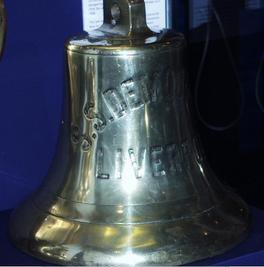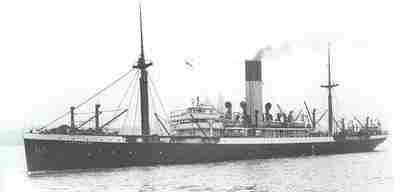The Liverpool Institute High School's Artefacts
- Ship's Bell
- Elgin Marbles
The ship's bell from S.S. Demodocus (I), 1912 |
|

The bell of the S.S. Demodocus of the Blue Funnel Line was given to the Liverpool Institute High School for Boys by Lawrence Durning Holt, chairman of the Governors. It was kept outside the Art Room on the first floor at the front of the building and remained there until the school's closure over thirty years later. The following two paragraphs appeared in the July 1951 edition of the School Magazine: "On January 31st., the Chairman of the Governors, Mr. Lawrence Holt, came to the School to present us with the ship's bell of S.S. "Demodocus"; with him was Captain Lacey, for many years master of the vessel. After both had addressed the School, Captain Lacey rang four bells in the Morning Watch on the newly installed bell" "On February 6th, the School learnt of the sudden and tragic death of the nation's greatly beloved and esteemed monarch, His Majesty, King George VI. On the day of the funeral of His Late Majesty a short ceremony was held in the School Hall: the two minutes silence were signalled by the ringing of the School Ceremonial Bell and preceded by the playing of Chopin's Funeral March on the organ. The School Vice-Captain, N.J. Page took part in the Civic Ceremony." At one time, the bell on the plinth had its clapper attached to the Headmaster's table on the stage in the hall by a length of fishing line, along with a written invitation to yank the line. The practice of ringing of the bell and running off was a popular way to get teachers running from the three rooms opposite the staircases, sometime even from the Staff Room. For a while, after the school closed, the bell was believed to be on display at the Maritime Museum, Liverpool. Jan Clein (Councillor for Arundel Ward, Liverpool City Council and a Blackburne House "Old" Girl) recalls that the Bell of the S.S. Demodocus was never owned by LIPA. The Bell never disappeared nor was it stolen. The Bell was owned by the Liverpool Institute High School and was sold to the Liverpool Museum (NMGM) - where it resided when the school closed - for £500. The money went into the Liverpool Institute Educational Foundation Trust (set up by the Charity Commission). Thanks for that Jan! John Hughes also reports that according to the Liverpool Museum's website, the Bell is at Sudley House Museum Mossley Hill. March 2012 - Follow Jim Lycett's efforts to restore the bell to it's rightful place. | |
|
|
|

|
|
|
DEMODOCUS (I) was built in 1912 by Workman Clark at Belfast with a tonnage of 6689grt, a length of 443ft, a beam of 52ft 9in and a service speed of 11 knots. Sister of the Perseus she was completed for the China Mutual Steam Navigation Co. in June 1912. She was taken over under the Liner Requisition Scheme in 1917 and on 23rd March 1918 she was torpedoed UC-53 in the Mediterranean with the loss of six lives. However she did not sink and was towed to Malta for repairs. In January 1949 she towed the Lycaon, which had lost her propeller, to Cape Town, a distance of 850 miles. During this time the Demodocus lost 20 days voyage time and consumed an additional 1154 tons of coal. Therefore, she claimed for loss of profit (£128 per day) and salvage against the Lycaon. The Court of Admiralty awarded £12,500 to the owners, £350 to the captain and £2,400 for division amongst the crew - a legal nicety bearing in mind that both ships were owned by the same company. In 1951 she was sold to Ditta Luigi Pittaluga Vapori of Italy for £51,000 and renamed Ircania. Five years later, in 1956, she was purchased by P. Tomei of Genoa who renamed her Miriam. On 10th October 1958 she arrived at Trieste where she was broken up. The 6,689-ton Demodocus was built in 1912 for the Blue Funnel Line by Workman Clark and Co. Ltd., Belfast. She survived both world wars despite being damaged, in March 1918, by a torpedo from a German submarine. In 1951 she was sold to Italian owners and broken up in 1958. |
|
The Elgin Marbles; missing from the art room.John Snelson writes:Much of this valuable information has been supplied by my friend Jim Lycett of New Zealand. I am with Jim all the way here and we need to get these marbles restored and lodged properly back in LIPA. Let's get behind Jim ! Jim Lycett writes:The Institute's Elgin Marbles (real or copies), were part of the frieze that hung all around the walls of Stan Reed's art room. Of course, the original Elgin marbles were taken from Greece and now are housed mainly in the British Museum with Greece claiming them back again. The other marbles that the Institute had, were the busts around the school hall and on the spiral staircase between the main entrance and Stan's art room. Also there was the very large marble bust presented to the school by the British Association which stood on its marble short column (plinth) outside the school office door opposite the main entrance to the hall. There were also the two large statues (marble or bronze) in the foyer in front of the iron gates. They were there in 1952/57 but the statues and the large bust were possibly removed to the College of Art during or just after that period. The busts from around the hall and the spiral staircase were apparently removed (probably) to the Art School about 1975 after one of them was knocked off its pedestal during the "rapid decline" in discipline at the school. Jim Lycett quoted Mark Featherstone-Witty, chief executive of LIPA writing on 14 July 1999, that they were housed in storage in the art school cellar. Actually there are some marbles (called in shorthand The Elgin Marbles) which have been housed in the basement of the art school next door; those are coming back - but the ones in the hallway seem to have gone for good. Okay ... so who's got these them and WHY? More information from Geoff Johnstone:I too can vouch for the Art Room having Greek reliefs mounted on iron brackets. I assumed they were plaster because they had a chipped, matt appearance, though that could have been layers of cheap Corpie paint. The busts on columns in the niches opposite the Art Room went missing about the time one of the columns was toppled and smashed by typical examples of the seventies intake. This was about 1975. Also I remember the bell on the plinth having its clapper attached to the Headmaster's table on the stage in the hall by a length of fishing line, along with a written invitation to yank the line. The practice of ringing of the bell and running off was a popular way to get teachers running from the three rooms opposite the staircases, sometime even from the Staff Room. On another occasion the bell had been lifted and the bar from which it was suspended had been pinched. On Jim Lycett's visit to LIPA about a year or so after it opened for students, he was told that there had been some marbles stored in the Innie's basement - below the spiral stairs near the old dining room - for some time after it opened. These then disappeared. On pressing M F-W for knowledge of the whereabouts of these marbles, he recalled/agreed that there had been some marbles when LIPA opened. Jim made enquiries at the Art School and received the following response:Hello, I have spoken to my boss and he informs me that all statuary work is either with the Liverpool City Council or in the basement of the Walker Art Gallery. We do not keep any work in the Liverpool Art School itself. On Mon, 21 Feb 2000, Jim Lycett wrote:Hi there, I found your email address through the J. Moores University web page as a contact person for the Liverpool School of Arts. Please can you assist me or pass this on to someone else who may be able to. I am trying to find the whereabouts of statuary that may be in the Art School's collection. The statuary was moved from the Liverpool Institute some years prior to its closing in 1985 and was possibly moved next door to the Art School - given the Institute's and the Art School's common origins and common school board at the times of the movements. The items I am searching for 2 x statues that used to stand in the entrance foyer of the Liverpool Institute and were moved probably in the late 1950s early 60s ( the email attachment shows an image of a gigantic marble bust of 'Maecennas' presented to the Institute in 1837 - probably moved at the same time as the two statues above, and 2 x marble medallions of William Huskisson and George Canning :- probably moved at the same time as the statues and/or Maecennas marble bust and 6 x busts presented to the Institute in 1838-1840 of - Michael Angelo, James Watt, Sir Isaac Newton, John Milton, William Shakespeare, one unknown. These were removed from the Institute about 1973 and I would be most grateful if you can please advise me if any of these items are (or have been) in the Art School's possession. Jim Lycett, Auckland, New Zealand. Now here is a verbatim response from John Coady, Building Manager at LIPA dated Monday 26 March 2001:Sorry but this is a bit of grey area for me but I will do my best. I am told the Elgin Marbles copes were made up six panels and under stand that the marbles still remained in the Institute at the time the school finely closed. Someone I have no idea who had the Marbles removed from the art room, however only three panels survived. The three remaining panels having been taken from the Institute building were stored in a cellar at the Art Collage the building next door to LIPA. Thanks to the help that I received from Professor C Crighton and John Freeman at JMU we now had them returned to the LIPA building and last year we had them installed to the side of the main entrench which we call the box office area.
|
